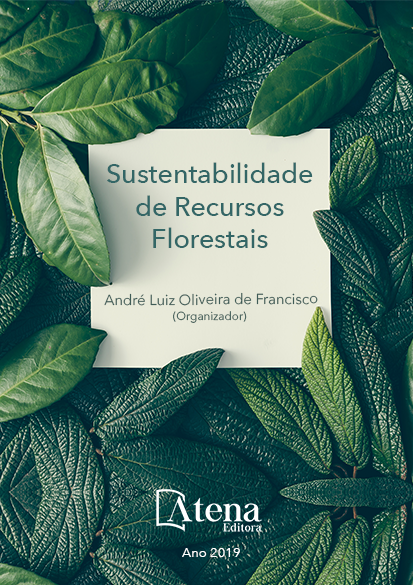
DESCRIÇÃO DA COMPOSIÇÃO FLORISTICA EM UMA UNIDADE DE MANEJO FLORESTAL NA AMAZÔNIA CENTRAL
O presente estudo teve como
objetivo descrever a vegetação arbórea de
uma floresta de terra firme na comunidade de
Lindóia, localizada no município de Itacoatiara-
AM. Os dados compõem um inventário florestal
de indivíduos com um diâmetro à altura do
peito (DAP) ≥ 40cm ocorrentes em uma área de
543,25 ha. Foi realizada a análise da composição
florística considerando o índice de valor de
importância (IVI) e da diversidade florística
utilizando os índices de Shannon Wiener (H´)
e Equitabilidade de Pielou (J). Adicionalmente,
foram avaliados freqüência, densidade, e
dominância da comunidade vegetal. Foram
observados um total de 14.608 indivíduos
distribuídos em 31 famílias botânicas, 79
gêneros e 101 espécies. As famílias com maior
número de indivíduos foram Lecythidaceae
(3.275), Fabaceae (2.273), Sapotaceae (2.011),
Lauraceae (1.472), Chrysobalanaceae (757),
Meliaceae (662), Moraceae (575), Celastraceae
(468), Humiriaceae (465) e Myristicaceae
(378). Estas famílias contribuem com 84,45%
do número de indivíduos, sugerindo que a
diversidade vegetal da área está concentrada
em poucas famílias. As espécies mais
importantes, segundo o IVI são Pouteria spp.
(20,11%), Eschweilera coriaceae (15,52%),
Cariniana micranta (10,61%), Helopixidium
latifolium (10,37%), Couepia leptostachya
(9,55 %), Erisma uncinatum (9,36%), Ocoteaa
neesiana (8,99%), Goupia glabra (8,27%),
Brosimum utile (7,27%) e Dimorphandra
parviflora (6,39%). O valor H´ foi de 3,78 e o grau
estimado de J (uniformidade) ficou em torno de
0,39. As duas primeiras classes de diâmetro,
medindo de 40-49cm e 50-59cm, foram as que
apresentaram um maior número de indivíduos,
contendo 71,73% dos indivíduos amostrados.
Estes seguem o padrão de “J” reverso comum
em florestas tropicais. Tais parametros são
importantes para futuros trabalhos envolvendo
distribuição de espécies.
DESCRIÇÃO DA COMPOSIÇÃO FLORISTICA EM UMA UNIDADE DE MANEJO FLORESTAL NA AMAZÔNIA CENTRAL
-
DOI: 10.22533/at.ed.4451916014
-
Palavras-chave: espécies amazônicas, floresta tropical, fitofisionomia.
-
Keywords: Amazonian species, tropical forest, physiognomy.
-
Abstract:
The present chapter describes the arboreous vegetation of a “terra firme”
forest in the community of Lindóia, located in the municipality of Itacoatiara (State of
Amazonas). A forest inventory dataset, containing individuals with a diameter at the
breast height (DBH) ≥ 40 cm and occurring in an area of 543,25 ha was analyzed
regarding to both forest composition and floristic diversity. Shannon Wiener index (H’)
and Pielou Equitability (J) were selected to determine the structure (i.e. Frequency,
Density, Dominance). A total of 14,608 individuals were measured and they were
distributed in 31 botanical families, 79 genera and 101 species. The families with the
highest number of individuals were in order Lecythidaceae (3,275), Fabaceae (2273),
Sapotaceae (2011), Lauraceae (1472), Chrysobalanaceae (757), Meliaceae (662),
Moraceae (575), Celastraceae (468), Humiriaceae 465) and Myristicaceae (378),
respectivelly. These families contribute with 84.45% of the number of individuals,
suggesting that the vegetal diversity of the area is concentrated in few families. The
most important species according to the Import Value Index (IVI) are Pouteria spp.
(20,11%), Eschweilera coriaceae (15,52%), Cariniana micranta (10,61%), Helopixidium
latifolium (10,37%), Couepia leptostachya (9,55%), Erisma uncinatum (9,36%), Ocoteaa
neesiana (8,99%), Goupia glabra (8,27%), Brosimum utile (7,27%) e Dimorphandra
parviflora (6,39%). The value of the Shannon index was 3.78 and the estimated degree
of Equatability (uniformity) was around 0.39. The first two diameter classes, measuring
40-49 cm and 50-59 cm, counted for 71.73% of the sampled individuals, following the
common “J” pattern. Such results are very important for future studies involving spatial
distribution of the species.
-
Número de páginas: 15
- Veraldo Liesenberg


